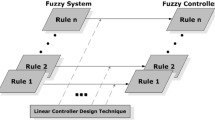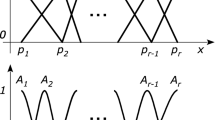Abstract
The Constant Modulus Algorithm (CMA), although it is the most commonly used blind equalization technique, converges very slowly. The convergence rate of the CMA is quite sensitive to the adjustment of the step size parameter used in the update equation as in the Least Mean Squares (LMS) algorithm. A novel approach in adjusting the step size of the CMA using the fuzzy logic based outer loop controller is presented in this paper. Inspired by successful works on the variable step size LMS algorithms, this work considers designing a training trajectory that it overcomes hurdles of an adaptive blind training via controlling the level of error power (LOEP) and trend of error power (TOEP) and then obtains a more robust training process for the simple CMA algorithm. The controller design involves with optimization of training speed and convergence rate using experience based linguistic rules that are generated as a part of FLC. The obtained results are compared with well-known versions of CMA; Conventional CMA, Normalized-CMA [Jones, IEEE conference record of the twenty-ninth asilomar conference on signals, systems and computers (Vol. 1, pp. 694–697), 1996], Modified-CMA [Chahed, et al., Canadian conference on electrical and computer engineering (Vol. 4, pp. 2111–2114), 2004], Soft Decision Directed-CMA (Chen, IEE Proceedings of Visual Image Signal Processing, 150, 312–320, 2003) for performance measure and validation.
Similar content being viewed by others
References
Godard D.N. (1980) Self recovering equalization and carrier tracking in two dimensional data communication systems. IEEE Transactions on Communications 28(11): 1867–1875
Treichler J.R., Agee B.G. (1983) A new approach to multipath correction of constant modulus signals. IEEE Transactions on Acoustics Speech and Signal Processing ASSP- 28: 459–472
Schirtzinger, T., et al. (1985). A comparison of three algorithms for blind equalization based on the constant modulus error criterion. In Proceedings of IEEE ICASSP (pp. 1049–1052).
Weerackody, V., & Kassam, S. A. (1991). Variable step size blind adaptive equalization algorithms. In IEEE international symposium on circuits and systems (pp. 718–721).
De Castro, F. C. C., et al. (2001). Concurrent blind deconvolution for channel equalization. In Proceedings of ICC (pp. II-366–II-371).
Chen, W. Y., & Haddad, R. A. (1990). A variable step size LMS algorithm. In Proceedings of the 33rd midwest symposium on circuits and systems (Vol. 1, pp. 423–426).
Özen, A., Kaya, I., & Soysal, B. (2007). Design of a fuzzy based outer loop controller for improving the training performance of LMS algorithm. In Third international conference on intelligent computing, ICIC 2007 August 21–24 (Vol. 2, pp. 1051–1063). Qingdao, China.
Lin H.-Y. et al (2005) An adaptive robust LMS employing fuzzy step size and partial update. IEEE Signal Processing Letters 12(8): 545–548
Sanubari, J. (2003). Fast convergence LMS adaptive filters employing fuzzy partial updates. In TENCON 2003, conference on convergent technologies for Asia-Pacific region (Vol. 4, pp. 1334–1337), Oct. 15–17, 2003.
Zhimin, D., et al. (2001). Novel variable step size constant modulus algorithms for blind multiuser detection. In IEEE VTS 54th vehicular technology conference, VTC 2001 Fall (Vol. 2, pp. 673–677), Oct. 7–11, 2003.
Baykal B. (2004) Blind channel estimation via combining autocorrelation and blind phase estimation. IEEE Transactions on Circuits and Systems-I: Regular Papers 51(6): 1125–1131
Zadeh L.A. (1965) Fuzzy sets. Information and Control 8: 338–353
Özen, A. (2005) A Fuzzy based outer loop controller design improving the performance and convergence speed in high data rate digital communication receivers. Ph.D. Thesis, Graduate School of Natural and Applied Science, KTU, Trabzon, July 2005.
Eminoğlu İ., Altaş İ.H. (1996) A method to form fuzzy logic control rules for a PMDC motor drive system. Elsevier Electric Power System Research 39: 81–87
Haykin S. (2002) Adaptive filter theory, (4th ed.). Prentice Hall Inc, New Jersey
Nascimento V.H., Silva M.T.M. (2008) Stochastic stability analysis for the constant-modulus algorithm. IEEE Transactions on Signal Processing 56(10, Part 1): 4984–4989
Cox E. (1994) The fuzzy systems handbook. Academic Press, Inc, London
Jones, D.L. (1996). A normalized constant modulus algorithm. In IEEE conference record of the twenty-ninth asilomar conference on signals, systems and computers (Vol. 1, pp. 694–697).
Chahed, I., et al. (2004). Blind decision feedback equalizer based on high order MCMA. In Canadian conference on electrical and computer engineering (Vol. 4, pp. 2111–2114).
Chen S. (2003) Low complexity concurrent constant modulus algorithm and soft decision directed scheme for blind equalization. IEE Proceedings of Visual Image Signal Processing 150: 312–320
Author information
Authors and Affiliations
Corresponding author
Rights and permissions
About this article
Cite this article
Özen, A., Kaya, İ. & Soysal, B. Variable Step-Size Constant Modulus Algorithm Employing Fuzzy Logic Controller. Wireless Pers Commun 54, 237–250 (2010). https://doi.org/10.1007/s11277-009-9723-2
Received:
Accepted:
Published:
Issue Date:
DOI: https://doi.org/10.1007/s11277-009-9723-2




